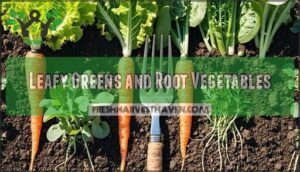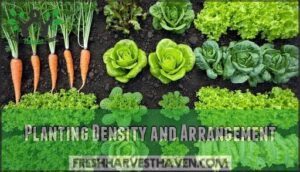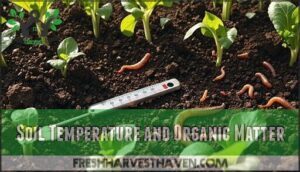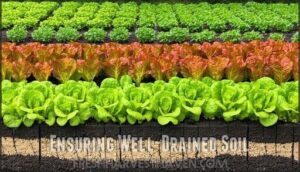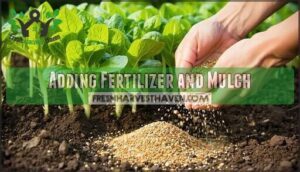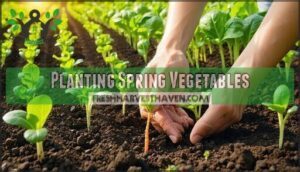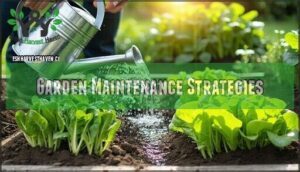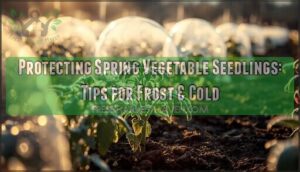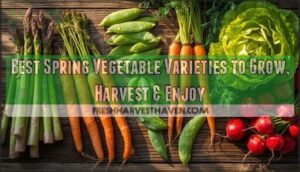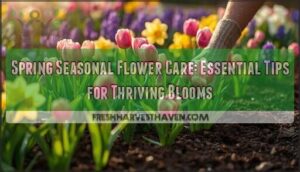This site is supported by our readers. We may earn a commission, at no cost to you, if you purchase through links.
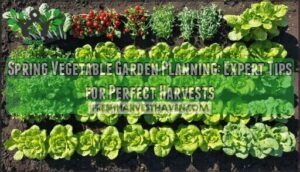
Start by preparing well-drained soil with organic matter, then map out your garden layout based on sun requirements and mature plant sizes.
Plant leafy greens every two weeks for continuous harvests, and don’t forget companion planting—carrots love tomatoes, while basil repels pests naturally.
The secret isn’t just what you plant, but understanding how soil temperature, spacing, and succession planting work together to create that picture-perfect garden that keeps producing all season long.
Table Of Contents
- Key Takeaways
- Spring Garden Planning
- Vegetable Selection Guide
- Soil Preparation Tips
- Planting Spring Vegetables
- Garden Maintenance Strategies
- Frequently Asked Questions (FAQs)
- How do you plan a spring vegetable garden?
- When to start planting vegetables for spring?
- What is the best way to layout a vegetable garden?
- What vegetables can and cannot be planted next to each other?
- When should I plant my spring vegetable garden?
- How do you prepare soil for spring vegetable garden?
- When should I start my spring vegetable garden?
- How do I plan my spring garden?
- How do you prepare a vegetable bed for spring?
- What vegetables are best to plant in the spring?
- Conclusion
Key Takeaways
- You’ll maximize your harvest by timing plantings 2-4 weeks before your last frost date and choosing cool-season crops like lettuce, peas, and radishes that thrive in temperatures between 50-70°F.
- You’ll create continuous harvests by implementing succession planting—sow new crops every two weeks and use companion planting strategies like pairing basil with tomatoes for natural pest control.
- You’ll ensure healthy plant growth by preparing well-drained soil with organic matter, testing soil temperature at 4 inches deep, and spacing plants according to their mature size requirements.
- You’ll maintain garden productivity through consistent watering, applying 2-3 inches of organic mulch around plants, and harvesting leafy greens in early morning when they’re at peak freshness.
Spring Garden Planning
You’ll need to identify your hardiness zone and last frost date before you start planning your spring vegetable garden layout.
Create a detailed plan that includes site selection for full sun exposure, crop scheduling based on soil temperature, and space allocation for cool-season vegetables like lettuce, spinach, and radishes.
Site Selection and Sun Requirements
Your spring garden’s success hinges on smart site selection. Choose locations with full sun—six hours daily minimum—for maximum vegetable growth.
Morning light exposure with afternoon partial shade protects tender plants from scorching. Consider microclimates around buildings and fences that create unique growing conditions.
Garden orientation matters: south-facing sites maximize sunlight management. For example, tomatoes need sunlight for maximum yields.
Make certain water access is within 50 feet to simplify maintenance tasks and ensure your garden receives the necessary care for optimal growth, considering the importance of full sun.
Garden Layout and Space Efficiency
Smart vegetable garden layout maximizes your harvest potential through strategic space planning.
Square foot gardening transforms small areas into productive powerhouses, while raised beds offer superior drainage and organization.
Here are three key layout strategies:
- Vertical gardening – Use trellises and stakes for climbing plants
- Companion planting – Group compatible vegetables together for mutual benefits
- Succession planting – Stagger sowings for continuous harvests throughout spring
Choosing Cool Season Crops
Once you’ve mapped your garden space, selecting the right cool season vegetables becomes your next priority.
These hardy crops thrive in temperatures between 50-70°F and tolerate light frosts.
Your variety selection should balance frost tolerance with flavor profiles while considering succession planting opportunities.
| Crop Type | Frost Tolerance | Harvest Timeline |
|---|---|---|
| Leafy Greens | Excellent (-2°F) | 30-45 days |
| Root Vegetables | Good (28°F) | 45-70 days |
| Brassicas | Very Good (25°F) | 60-90 days |
| Legumes | Moderate (32°F) | 50-65 days |
Smart spring vegetable garden planning means choosing coolseason crops with natural pest resistance.
Early spring garden success depends on matching your local climate with appropriate cool season vegetables for ideal harvests.
Vegetable Selection Guide
You’ll need to match specific vegetables to your garden’s conditions and space requirements for successful spring harvests.
Cool-season crops like lettuce, spinach, and radishes thrive in spring temperatures, while proper spacing guarantees each plant receives adequate nutrients and sunlight, which is crucial for a successful harvest.
Leafy Greens and Root Vegetables
Cool season vegetables like lettuce, spinach, and carrots form your garden’s foundation.
These leafy greens and root vegetables have different nutrient needs—greens prefer nitrogen while roots need phosphorus.
Plan companion planting carefully since carrots pair well with lettuce but compete with beets.
Consider harvest timing when selecting varieties, as some store better than others for extended enjoyment.
Planting Density and Arrangement
Proper plant spacing transforms your garden from crowded chaos into productive paradise. Square Foot Gardening maximizes yields by preventing crowded plants from competing for nutrients and sunlight.
Consider mature size when planning your garden layout.
Here’s your density blueprint:
- Carrots: 16 per square foot for ideal root development
- Lettuce: 8 plants per square foot using intensive cropping methods
- Radishes: 16 per square foot with succession planting every two weeks
- Spinach: 4 plants per square foot for full leaf expansion
- Broccoli: 2 plants per square foot with vertical planting methods for support.
Using a planting calendar helps guarantee correct timing.
Companion Planting Strategies
Strategic companion planting transforms your spring garden into a pest-fighting powerhouse.
Plant basil near tomatoes for natural pest deterrents while enhancing flavor. Onions paired with carrots create effective growth enhancement through nutrient cycling.
This vegetable garden plan maximizes space optimization by attracting beneficial pollinators. Your spring vegetable planting strategy should pair plants with similar water and sunlight needs for ideal plant spacing results, creating a well-designed garden that is a true powerhouse.
Soil Preparation Tips
Proper soil preparation sets the foundation for healthy spring vegetables that’ll produce abundant harvests throughout the growing season.
You’ll need to test soil temperature, add organic matter, and make certain good drainage before planting your cool-season crops.
Soil Temperature and Organic Matter
Your soil temperature determines when you can plant spring vegetables successfully.
Soil thermometers help you monitor temperatures at four inches deep, ensuring ideal conditions for seed germination.
Organic material like compost types and soil amendments boost microbial activity while improving soil quality through natural soil enrichment processes.
Knowing your soil type is essential, so consider performing soil tests for ideal growth.
- Check soil temperature at 8 a.m. for accurate readings
- Add compost and organic matter for long-term soil preparation spring success
- Monitor microbial activity levels to gauge soil health improvements
Ensuring Well-Drained Soil
Water-logged roots spell disaster for spring vegetables, so drainage solutions become your garden’s lifeline.
Test your soil by digging a hole and filling it with water—proper drainage means it empties within 24 hours.
Combat soil compaction by adding coarse sand or perlite to heavy clay.
Consider various soil amendments to improve drainage. Raised beds offer the ultimate fix for poor soil quality when amendments aren’t enough.
Adding Fertilizer and Mulch
Timing matters when you apply fertilizer to your garden soil mix.
Add compost or vegetable-specific fertilizers in early spring when soil temperatures reach 50°F. These organic options provide steady soil enrichment throughout the growing season.
Apply fertilizer before mulching to guarantee proper soil preparation. Water thoroughly after garden fertilization, then add mulch for maximum benefits and moisture retention.
Using balanced spring fertilizers guarantees ideal plant growth and fruiting.
Planting Spring Vegetables
Once you’ve prepared your soil properly, you’re ready to plant your spring vegetables using the right techniques for each crop type.
You’ll need to master direct sowing methods, proper seed depths, correct spacing distances, and support systems to guarantee your cool-season crops thrive in the garden, which involves understanding complete concepts.
Direct Sowing and Transplanting
Choosing between direct sowing and transplanting sets the foundation for your spring vegetables’ success.
Each method offers distinct advantages depending on your crops and growing conditions. Seed starting indoors gives you better control, while direct sowing works perfectly for many spring vegetables. Many gardeners find success when planting seeds directly.
- Hardening off transplants gradually over 7-10 days before planting outdoors
- Root disturbance sensitivity varies – carrots hate it, broccoli tolerates it well
- Transplant shock appears as wilting leaves and stunted growth initially
- Starting seeds indoors extends your growing season by 4-6 weeks
- Direct sowing works best for radishes, peas, and other quick-germinating crops
Sowing Seeds at The Right Depth
Getting your seed depth right makes the difference between thriving plants and disappointing gaps in your spring garden planning.
Most seeds need planting at depths equal to twice their diameter – tiny lettuce seeds barely get covered, while larger pea seeds go down half an inch.
Check your seed packets for exact measurements, as proper depth directly impacts germination rate factors and guarantees successful growing from seeds.
Spacing and Thinning
Proper seedling density prevents overcrowding effects that stunt growth and reduce yields.
Thin overcrowded seedlings when they’re two inches tall, using sharp scissors to cut at soil level. Space remaining plants according to seed packet instructions—carrots need one inch apart, lettuce requires four inches.
To avoid damping off, it’s important to sanitize seeding containers before planting. This resource allocation guarantees maximum growth during your spring planting guide timeline through strategic succession planting intervals.
Providing Support for Climbing Vegetables
Support structures transform climbing vegetables from sprawling space-hogs into productive vertical gardens. Strategic vine training maximizes your spring planting guide success while saving precious ground space.
Smart trellis options boost your garden’s potential:
- Install 6-foot bamboo poles for peas and snap peas
- Build A-frame wooden trellises for heavy climbers
- Use wire mesh panels against fences or walls
- Create teepee structures with three sturdy stakes
- Add horizontal strings between posts for gentle support
Vertical structures deliver increased yields in compact areas, making them a great option for smart trellis systems and strategic vine training to achieve productive results.
Garden Maintenance Strategies
Once you’ve planted your spring vegetables, you’ll need consistent maintenance strategies to guarantee healthy growth and maximum yields.
Proper watering, pest control, and timely harvesting will keep your garden productive throughout the growing season, ensuring healthy growth.
Watering and Mulching
Water your spring vegetables consistently, checking soil moisture two inches deep before irrigating.
Organic mulch like shredded leaves or straw retains moisture while suppressing weeds and moderating soil temperature fluctuations.
Apply mulch two to three inches thick around plants, keeping it away from stems to prevent rot.
This garden water management strategy reduces watering frequency substantially.
Controlling Pests and Diseases
After establishing proper watering routines, you’ll need effective pest identification skills to protect your spring crops.
Garden pest management starts with weekly scouting for aphids, beetles, and leaf damage.
Disease prevention relies on crop rotation and removing infected plant debris.
Many gardeners find success with integrated pest management, and natural pest control methods like beneficial insects and organic pesticides work best when combined with proper garden sanitation practices.
Harvesting and Post-Harvest Care
Perfect harvest timing transforms your spring vegetables from garden-fresh to plate-ready treasures. Understanding when each crop reaches peak flavor guarantees maximum nutritional value and taste.
- Harvest timing: Pick leafy greens in early morning when leaves are crisp and full of moisture
- Proper storage: Store root vegetables in cool, humid conditions to maintain freshness
- Extending freshness: Wash vegetables just before use to prevent premature spoilage
- Seed saving: Allow select plants to bolt for next season’s planting
- Composting waste: Turn vegetable scraps into nutrient-rich soil amendments
Common Challenges and Solutions
Spring gardening frustrations stem from predictable culprits.
Pest control requires early intervention with beneficial insects and organic sprays. Soil issues demand testing and organic amendments.
Weather woes need frost protection using row covers. Space constraints benefit from vertical growing and succession planting.
Watering problems solve with consistent moisture monitoring. Effective garden planning prevents most challenges through proper timing and preparation, including using row covers.
Frequently Asked Questions (FAQs)
How do you plan a spring vegetable garden?
Transform your growing space into a productive paradise by identifying your hardiness zone, determining last frost dates.
Selecting cool-season crops, preparing well-drained soil, and designing efficient layouts that maximize harvests throughout spring’s fleeting season.
When to start planting vegetables for spring?
Start planting cool-season vegetables 2-4 weeks before your last frost date.
Check your hardiness zone first, then monitor soil temperature with a thermometer.
Plant frost-hardy crops like peas and spinach earliest.
What is the best way to layout a vegetable garden?
Like pieces of a puzzle falling into place, your garden layout should maximize space and sunlight.
Use raised beds or square-foot grids, place tall plants north, and group crops by watering needs for ideal growth.
What vegetables can and cannot be planted next to each other?
Companion planting pairs compatible vegetables while avoiding harmful combinations.
Plant tomatoes with basil, carrots with onions, and beans with corn.
Don’t plant onions near beans or carrots near dill—they’ll stunt each other’s growth, which is a key concept in companion planting to ensure healthy growth.
When should I plant my spring vegetable garden?
Timing is everything when planting your spring garden.
You’ll want to start cool-season crops like lettuce, spinach, and peas two to four weeks before your area’s last frost date for ideal growth.
How do you prepare soil for spring vegetable garden?
Remove weeds and debris, then work compost into your soil.
Test pH levels and adjust if needed.
Add organic fertilizer to boost nutrients. Make certain proper drainage and break up compacted areas for healthy root development, ensuring healthy root growth is supported.
When should I start my spring vegetable garden?
Cool-season crops can tolerate temperatures as low as 25°F, giving you a head start on growing season.
You’ll want to start your garden 2-4 weeks before your area’s last expected frost date for best results.
How do I plan my spring garden?
You’ll want to map out your space first, then choose crops that thrive in cool weather.
Consider your last frost date, plan succession plantings, and make certain you have well-draining soil with full sun exposure.
How do you prepare a vegetable bed for spring?
Give your soil some TLC by testing pH levels, mixing in rich compost, and clearing away winter’s debris.
You’ll want to work the earth when it’s not soggy to avoid compaction issues.
What vegetables are best to plant in the spring?
Plant cool-season crops like lettuce, spinach, carrots, radishes, and peas in spring.
These vegetables thrive in cooler temperatures and can handle light frosts, giving you fresh harvests before summer heat arrives.
Conclusion
Perfect timing beats perfect conditions every time.
Even if your garden space seems too small or your soil isn’t ideal, effective spring vegetable garden planning transforms any plot into a productive haven.
You’ve learned the fundamentals: timing plantings with frost dates, selecting appropriate cool-season crops, preparing soil properly, and implementing succession planting techniques.
Start with one small section this season, apply these proven methods consistently, and watch your confidence grow alongside your vegetables.
Your harvest success begins now.
- https://livetoplant.com/the-science-behind-soil-temperature-and-plant-growth/
- https://cmg.extension.colostate.edu/Gardennotes/720.pdf
- https://farmerflints.com/blogs/news/what-seeds-to-plant-in-spring-a-comprehensive-guide-for-a-thriving-garden
- https://www.rainbird.com/homeowners/blog/5-vegetable-garden-planning-and-planting-tips-for-spring
- https://extension.oregonstate.edu/news/add-organic-matter-improve-garden-soils


